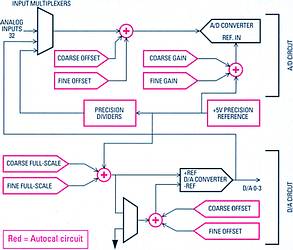
Analog I/O boards by their very nature require occasional calibration to maintain their accuracy. Most analog I/O boards utilise potentiometers to control the calibration process.
Look at the top edge of Diamond-MM-16, Diamond-MM and Sapphire-MM boards, and just about anyone else's boards and you will see the blue pots that are used for calibration. These pots are inexpensive and work well. However, for embedded systems, they pose a few problems. First of all, the board is buried inside a stack of boards inside an enclosure and getting to the board to calibrate it can be difficult and time-consuming. Also, in a high-vibration setting, the pots could vibrate out of calibration or actually come off the board. The pots are also subject to accidental misadjustment. Finally, the calibration process requires time, written instructions and extra equipment.
Autocalibration solves all these problems in an elegant way. All the calibration signals and intelligence are built right into the board. A software command or a utility program is all that is needed to calibrate the board. Calibration is instant and accurate and can be performed as often as desired, for example every time the system is powered up. And because the calibration is totally automatic, the board does not need to be physically handled during the process, which means it can be calibrated while installed in the end system.

How autocalibration works
Our autocalibration circuit uses an octal 8 bit TrimDAC IC to provide small adjustments to the offset and gain at various points in the circuit. Four of the DACs are used for the A/D calibration and the other four are used for the D/A. The 8 bit TrimDAC values are stored in an on-board EEPROM and are recalled automatically on power-up.
An on-board ultra-stable +5 V reference chip with 5 ppm offset drift is used as the voltage reference for all calibration operations. Derived from this reference are several intermediate values that are used for the calibration. One is just under +5 V, and one is just above 0 V. These values are measured at the factory and their values are stored in the on-board EEP-ROM for use by the calibration program. Note that the actual values of the reference signals does not matter, as long as they are stable, since the calibration routine knows the values and can adjust the calibration circuit to achieve them. An extra analog input multiplexor chip is used to feed the calibration voltages into the A/D circuit during the process.
For bipolar A/D calibration, first 0 V is measured and the TrimDAC is adjusted until the target A/D reading is achieved. For unipolar calibration, the voltage just above 0 is used as the first measurement value. Two TrimDAC channels are used for the offset. The first channel provides a coarse adjustment to bring the A/D readings into range, and then the second channel provides a fine adjustment for maximum accuracy. The use of both coarse and fine adjustments provides a wider range of total adjustment capability. The coarse and fine adjustments overlap, so there is no gap in the adjustment range.
After the offset is adjusted, the full-scale is adjusted in a similar manner. The reference value just under 5 V is fed into the A/D, and two additional TrimDACs provide coarse and fine adjustments to achieve the target A/D near-full-scale reading.
Once the A/D is completely calibrated, the 12 bit D/A channels can be calibrated. Unlike the A/D circuit, which uses a single A/D for all input channels, the D/A circuit actually contains a single D/A converter for each of the four output channels. These channels are fed into the calibration multiplexor and the remaining four TrimDAC channels are used to calibrate them in the same manner as the A/D: coarse/fine for offset, and coarse/fine for full-scale.
The entire process takes about 1 s. Once it is complete, the board is ready to run. All eight TrimDAC values are stored in the EEPROM so that the next time power is cycled to the board, the values will be loaded automatically.
Electronic Product Design
(012) 665 9700

© Technews Publishing (Pty) Ltd | All Rights Reserved